Shuangta Mountain Scenic Area is located in Shuangluan District, Chengde City, Hebei Province. It is a famous scenic spot combining nature and humanity in Chengde, and a national 4A-level tourist attraction. The scenic area centers on two towering giant rock peaks, each with an ancient pagoda on top, hence the name "Shuangta Mountain" (Twin Pagoda Mountain). The total area of the scenic area is about 600 hectares, with a high forest coverage rate. It features unique natural landscapes and long-standing cultural relics, making it a tourist resort integrating sightseeing, leisure and exploration. Among them, the two peaks of Shuangta Mountain are about 40 meters and 30 meters high respectively. The mountain is steep and difficult to climb, and the ancient pagodas on the top add a mysterious color, attracting many tourists to explore.
History and Culture
The historical and cultural value of Shuangta Mountain is mainly reflected in the two ancient pagodas on the top of the mountain. According to research, these two ancient pagodas were built in the Liao Dynasty, with a history of nearly a thousand years. There is no clear record in history about the purpose of building the ancient pagodas, which also casts a mysterious veil over them. There is a legend that they are auxiliary buildings of the tombs of the nobles of the Liao Dynasty, and there is also a saying that they are related to religious activities at that time.
Through the long river of history, Shuangta Mountain and the ancient pagodas have withstood wind and rain erosion and dynastic changes, but still remain to this day, becoming important physical materials for studying the architectural art and historical culture of the Liao Dynasty. Emperor Qianlong of the Qing Dynasty was quite interested in Shuangta Mountain. He once sent people to try to climb to the top of the peak to explore the mystery of the ancient pagodas, but failed due to the steepness of the mountain. Only relevant records were left, adding more historical heritage to the scenic area.
Main Attractions
Shuangta Peaks (Twin Pagoda Peaks)
Shuangta Peaks are the core attractions of the scenic area, consisting of two towering giant rock pillars. The east peak is about 40 meters high, the west peak is about 30 meters high, and the distance between the two peaks is about 30 meters. The rock pillars are purple-red, hard in texture, and steep on the surface, almost perpendicular to the ground, which can be called the uncanny workmanship of nature. There is an ancient pagoda on each peak. The pagoda on the east peak is about 2 meters high, and the one on the west peak is about 5 meters high. Both are brick structures with architectural traces such as doors and windows on the tower body. They have a simple shape, showing the architectural style characteristics of the Liao Dynasty.
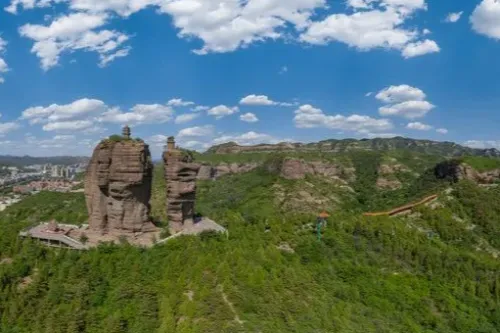
Golden Turtle Stone
Golden Turtle Stone is located near Shuangta Peaks. It is a huge stone shaped like a turtle, about 5 meters long, 3 meters wide and 2 meters high. The shape of the boulder is lifelike, with clear outlines of the head and back, as if a huge turtle is looking up at Shuangta Peaks, hence the name. Golden Turtle Stone is surrounded by green trees, which complement the surrounding natural landscape, making it a good place for tourists to take photos as a souvenir.
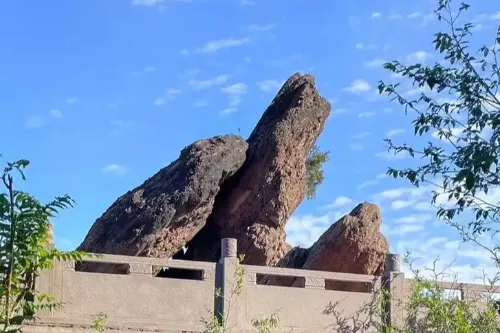
Camel Peak
Camel Peak gets its name because it resembles a camel in shape. The peak is approximately 25 meters high and 40 meters long. From a specific angle, the camel's head, humps, body and other parts are clearly distinguishable, with vivid and lifelike forms. The mountains around Camel Peak undulate, and the vegetation is dense. Tourists can enjoy this unique natural landscape during their climb.
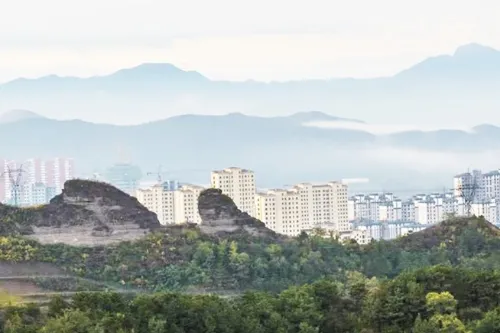
Sanxian Guan (Three Immortals Temple)
Sanxian Guan is a Taoist temple with a strong incense. The couplet on the pillars of the temple gate, "Tao connects Tai Chi and circulates outside heaven and earth; the heart penetrates the profound and mysterious, which is the wonder of the universe", shows the mysterious realm of Taoism. The couplet inside the hall expresses the wishes of believers for good fortune and protection from the stars. On the left is Zhao Gongming, the God of Wealth, in the middle is Wenqu Star, also known as "Zitong Emperor", and on the right is Sun Simiao, the King of Medicine. The three immortals are in the same hall, which is a treasure carrying rich historical culture and folk beliefs.
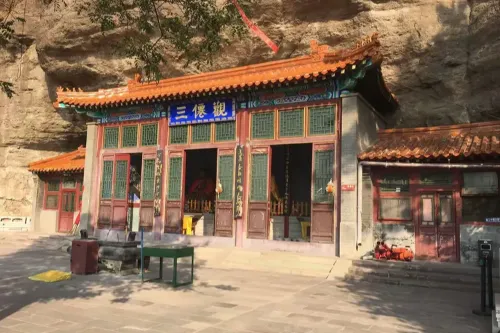
Qibao Lou (Seven Treasures Building)
Qibao Lou is modeled after the Qing-style half-hall building, constructed along the mountain terrain. It is 4 meters wide and 5 meters high. The couplets outside the hall depict the special scenes at the birth of the Sudhana Boy and his virtues of seeking knowledge and respecting the worthy. Inside the hall, along the natural cave, 53 of his spiritual masters are enshrined. The main statue is a reversed-seated Guanyin, modeled after the one in Longxing Temple in Zhengding. With a serene face and a peaceful sitting posture, it seems capable of relieving worldly troubles. The Buddha statues vary in size, with the tallest being 1 meter and the smallest only 70 centimeters. They are exquisitely arranged, each with its own unique features.
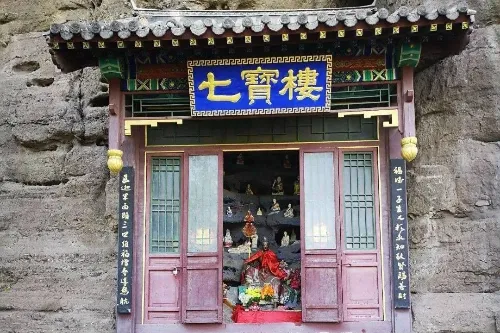
Hongshan Culture Map
Hongshan Culture is a relatively important Neolithic culture in northern China. It originated in southern Inner Mongolia, northern Hebei and northeastern Hebei. Hongshan Culture dates back about 5,000 to 6,000 years ago and lasted for about 2,000 years. The most representative of Hongshan Culture are the Hongshan Goddess and the Hongshan Jade Pig Dragon. In the middle of the picture is the scene of the Hongshan Goddess sacrificing after a bumper harvest, with people farming, sowing and sacrificing for the harvest. In the late 1970s, large-scale investigations were carried out on Hongshan Culture relics in Inner Mongolia, northern Hebei and western Liaoning, and nearly a thousand sites were discovered. A large number of precious cultural relics were found, such as stone tools, pottery and jade articles. Hongshan Culture has important historical value. The emergence of Hongshan Culture made the Xar Moron River basin, together with the Yellow River basin and the Yangtze River basin, become the three sources of Chinese civilization, advancing the study of the origin of Chinese civilization from 4,000 years ago to 5,000 years ago! Since then, the Khitan people withdrew from the stage of Chinese history and disappeared in the long river of history.
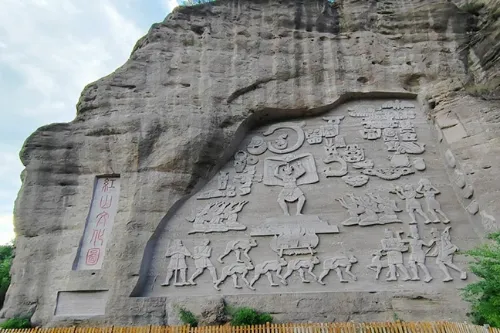
Origin Map of the Khitan
The Khitan people were an early minority nomadic people in Chinese history. As a nomadic people, the Khitan people were active in the long river of Chinese culture a long time ago. It is said that a long time ago, a fairy riding a white horse from the Laoha River and a heavenly fairy driving a green ox cart from the Xar Moron River met and fell in love at the Liao River. After marriage, they had eight sons, who later multiplied into eight Khitan tribes. They are: Xiwandan Tribe, Hedah He Tribe, Fufuyu Tribe, Yuling Tribe, Rilian Tribe, Pixu Tribe, Li Tribe and Tuliu Tribe. The Khitan people established the Khitan State in 916 AD, and changed the country's name to Great Liao in 947 AD. The Khitan Dynasty existed in Chinese history for more than 200 years, with 9 emperors in total, and was destroyed by the Jin Dynasty in 1125 AD!
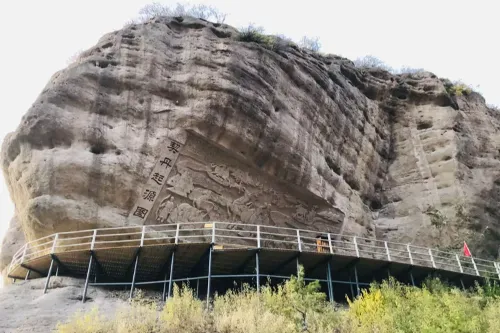
Guifu Shengong (Divine Ax and Magical Work)
It is a large-scale cliff carving, which is unique in northern Yan. It is located in the valley on the southeast side of Camel Peak. A huge stone next to the road splits vertically into two pieces. One of them is 24.3 meters high and about 18.5 meters wide, forming a cliff face, standing beside the road, with the words "鬼斧" (Divine Ax) engraved on it. Each character is about 8 meters high and 6 meters wide, and the blue outlined characters are particularly eye-catching.
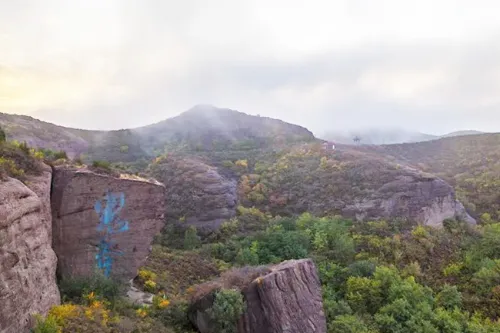
The other boulder lies obliquely in the valley, only 8 meters away from the cliff. The length, width and texture of the boulder are consistent with the cliff, exactly the same, as if some god split the boulder from the cliff or sedimentary rock in one go, dividing it into two. The words "神工" (Magical Work) are written on the boulder, also outlined in blue. The four characters "鬼斧神工" are in running script, with careful strokes, strong and varied, and are the calligraphy works of the famous calligrapher Yao Xiaoyao.
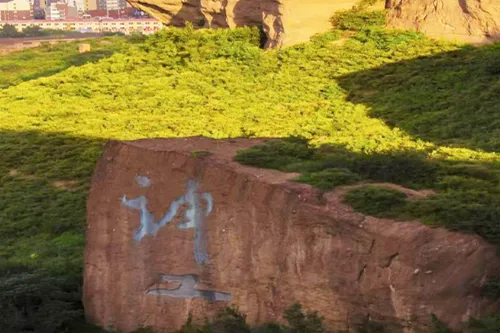
Liao and Qing Exhibition Hall
The Liao and Qing Exhibition Hall has two floors, divided into five exhibition halls. The first four exhibition halls mainly use lifelike wax figures of characters to reproduce the major historical events of the Qing emperors in Chengde. The fifth hall displays the funeral culture and customs of the Liao Dynasty. The first hall, with 160 small wax figures, shows the scene of Kangxi's northern tour to Mulan Paddock for hunting. Its main purpose is to improve the combat effectiveness of the Eight Banners soldiers and deter the small countries on the border. The second hall, with lifelike large wax figures, shows the scene of Emperor Qianlong meeting the Sixth Panchen Lama in the Sizhi Study of the Mountain Resort. The third hall, with lifelike large wax figures, shows the scene of Emperor Xianfeng entrusting his orphans on his deathbed in the Yanbo Zhishuang Hall of the Mountain Resort. The fourth hall, with 1:10 small wax figures, shows the scene of Emperor Xianfeng's coffin being transported back to Beijing from Chengde. The fifth hall reviews the ancient pagodas of the Liao Dynasty and the funeral culture and customs of the Liao Dynasty through historical relics.
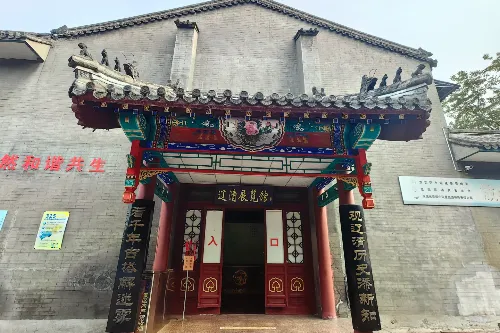
Wild Macaques in Shuangta Mountain
In the early 1990s, a group of about 20 wild macaques came near Shuangta Mountain. In the early 2000s, in order to protect these small animals, by understanding their habits, fixed-point and regular feeding was carried out, and a protected area was established to provide a place for these wild macaques to multiply and live. Through effective protection, the number of wild macaques in the scenic area increases by 6-10 each year. After years of careful care and feeding, the monkey group has developed to more than 100, which is a beautiful scenery in the scenic area.
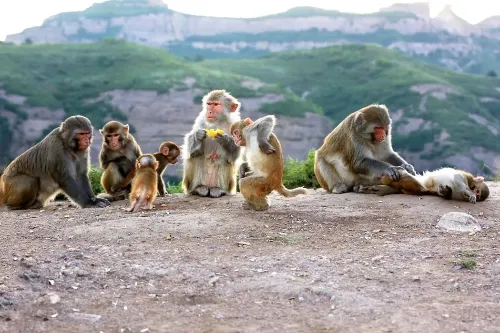
Tour Routes
Classic Half-Day Tour Route, duration about 3 hours: East Gate Entrance → (Sightseeing Bus/Walking for 15 minutes) → Shuangta Mountain Viewing Platform → (Trail for 10 minutes) → Sanxian Guan → (Yunti Staircase for 30 minutes) → Top Platform (Close view of Shuangta) → Return the same way or go down the mountain via the west trail
In-depth One-Day Tour Route, duration about 5-6 hours: West Gate Entrance → (Hiking for 30 minutes) → Valley Stream Trail → (15 minutes) → South Viewing Platform (Photography spot) → (20 minutes) → Ape Man Stone → (Cliff Plank Road for 40 minutes) → Glass Viewing Platform → (Going down the mountain for 30 minutes) → Liao Dynasty Stone Carving Group → East Gate Exit
Travel Suggestions
- It is recommended to spend 1 day visiting to have sufficient time to explore the main attractions in the scenic area.
- There are many mountain roads in the scenic area, so it is advisable to wear comfortable sports shoes for easy hiking and walking.
- When visiting in summer, take sun protection measures, such as bringing a sun hat, sunglasses, and sunscreen; in winter, keep warm by wearing thick clothes.
- There are relatively few catering facilities in the scenic area. It is recommended to bring an appropriate amount of drinking water and food, and eat in designated areas to maintain environmental hygiene.
- The best seasons to visit are spring and autumn. In spring, everything comes back to life with fresh scenery; in autumn, the weather is cool and the mountains are rich in colors.
- You can bring a camera or mobile phone to record the beautiful and unique landscapes in the scenic area.
Matters Needing Attention
- Some sections in the scenic area are steep. When visiting, pay attention to safety and do not leave the designated trails without permission to avoid danger.
- Protect the natural landscapes and cultural relics in the scenic area. Do not scribble or damage them at will.
- Abide by the scenic area regulations. Do not smoke or use open flames in fire-prohibited areas to prevent fires.
- Take good care of the elderly and children to avoid getting separated or having accidents.
- Wild animals may appear in the scenic area. Do not disturb them when encountering them and keep a safe distance.
- In thunderstorm weather, take shelter in a safe indoor area or lightning protection facility. Do not stay on the top of the mountain or in open areas.
Transportation
- Bus: In the urban area of Chengde, you can take buses such as No. 15, No. 52, and No. 55 to Shuangta Mountain Scenic Area Station, then walk about 500 meters to reach the scenic area gate.
- Self-driving: Starting from the urban area of Chengde, drive west along Xidajie, turn into Shuangta Mountain Street, and follow the road signs to reach the scenic area. There is a parking lot in the scenic area, and the parking fee is 5 yuan per hour.
- Taxi: Taking a taxi from the urban area of Chengde to Shuangta Mountain Scenic Area is about 15 kilometers, and the fare is about 30-40 yuan.
Opening Hours
The opening hours will be adjusted according to the season. In summer (April 1st - October 31st), the opening hours are 7:30-18:00; in winter (November 1st - March 31st of the next year), the opening hours are 8:00-17:00. The scenic area stops selling tickets 1 hour before closing. Please arrange your visiting time reasonably.
Tickets
As of August 14, 2025, the ticket price is 50 yuan per person. You can search for the service account "双塔山风景区" on WeChat to get the latest updates or buy tickets online.
